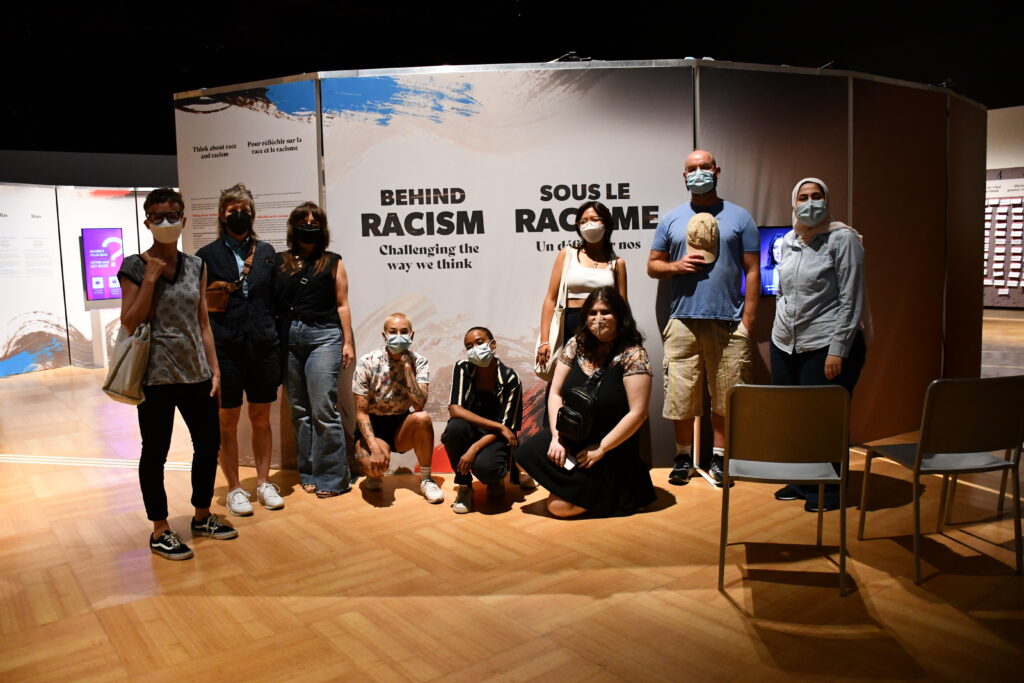
On July 22, 2022, Museum Queeries took a trip to the Canadian Museum for Human Rights to see the temporary exhibit “Behind Racism: Challenging the Way We Think.” This exhibit, which aims to explore how systems of perception influence beliefs and actions, was developed in partnership by the Canadian Race Relations Foundation and the Ontario Science Centre. Read the resulting SnapThoughts below.
To learn more about the exhibit, click here.
“The Canadian Human Rights Museum’s newest exhibit ‘Behind Racism: Challenging the Way We Think’ gave me insight on how racism can be viewed through a scientific lens. The exhibition had varied information and activities on how we as humans might intentionally or unintentionally treat someone based on the colour of their skin, religion, sex, sexuality, etc. Taking a queer perspective while walking through the exhibit, I noticed that there was not much overlap of the various identities that were mentioned throughout the exhibit. For example, an installation depicted which demographic groups are most affected by racially motivated hate crimes and report them to the police, which I believe is a good start. I only hoped that there could have been statistics on the ways those groups, such as Black and Indigenous people, are policed as well as how Trans and Two-Spirit Black and Indigenous people are reporting crimes against them. Although the exhibit has gaps, I can see how it is educational for some people, especially children. As such, it prompts the question of who is this exhibit for? And who does it benefit? It makes me think critically about whether there was a specific demographic in mind when they had planned ‘Behind Racism: Challenging the Way We Think.’” – Mahlet Cuff
“It was difficult not to meditate on the museum’s baggage prior to touring its ‘Behind Racism’ exhibit. I felt that the CMHR’s history of racism, specifically anti-black racism, was also on the minds of the colleagues whom I toured the museum with that day. Our conversations before touring buzzed around the events and incidents that took place within the museum that really only came to light the past two years (see #cmhrstoplying). It was maybe because of these conversations that made me think that the exhibit would be a way for the museum to hold itself accountable for its own fraught history. The exhibit, though, left the museum out of the conversation of racism. It focused on the science behind racism and the internal psychological functions that may lead to racist affect, cognition, and behaviour within individuals. Although interesting, the exhibit only worried me. I worried that this focus on the internal and individual perspectives towards racism simplified racism, that it is simply the result of individuals who don’t empathize with one another, and so, to solve it, individuals should just think away their internal biases. I worried that these perspectives blur the ways in which racism functions systematically, or even institutionally, specially within the very space in which the exhibit takes place.” – Mika Castro
“Visiting the ‘Behind Racism’ exhibition at the Canadian Museum for Human Rights was both enlightening and underwhelming. While introducing foundational topics within anti-racism discourse remains integral to challenging our understandings of the world and its systemic and individual injustices, I found the language to be surface level. As an Indigenous person, I am already well-versed in racial oppression and colonial violence, and I do not believe that I was the targeted demographic for this exhibition. Rather, it is apparent that it’s geared towards white people who have minimal knowledge regarding critical racial discourse and awareness surrounding white supremacy. Therefore, I do believe the exhibition is helpful to its targeted audience, however, I didn’t find it particularly helpful to dismantle my own biases, as I continue to do that work in a more productive and insular way. Additionally, I did not see any programming to accompany the exhibition, which feels like a lost opportunity to engage with community members about this essential information and work through difficult topics in a personal and effective manner. Regardless, the exhibition encourages significant critical discourse by making concerted efforts to unravel the ongoing oppression and violence we see in our society today.” – Adrienne Huard
